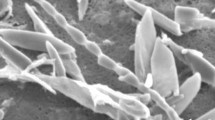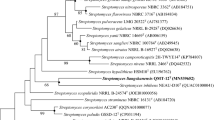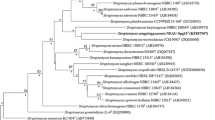Abstract
Strain JXJ 0135T, an anti-cyanobacterial actinomycete, was isolated from a soil sample collected from Lushan Mountain, south China, and identified by using polyphasic approach. Phylogenetic analysis of the near-complete 16S rRNA gene sequence indicated that strain JXJ 0135T belongs to the genus Streptomyces and exhibited distinct subclade and also highest similarity (98.6%) to Streptomyces scopuliridis RB72T. The strain developed well-branched substrate and aerial mycelia, and produced spiral spore chains. Spores were elliptical and the spore surface was smooth. The strain contained LL-diaminopimelic acid with whole-cell sugars of mannose, rhamnose, glucose and galactose. Phospholipids were diphosphatidylglycerol, phosphatidylethanolamine, phosphatidylinositol mannosides, phosphotidylinositol dimannoside, an unidentified aminophospholipid and an unknown phospholipid. The menaquinones were MK-9(H6) and MK-9(H8). The major components of the fatty acids were anteiso-C15:0, iso-C16:0, anteiso-C17:0, iso-C15:0, C16:0, iso-C17:0 and iso-C14:0. The G+C content was 69.3 mol%. The DNA–DNA hybridization value between JXJ 0135T and S. scopuliridis RB72T was 41.2±1.4%. On the basis of the polyphasic data, strain JXJ 0135T represents a novel species of the genus Streptomyces, for which the name Streptomyces lushanensis sp. nov. is proposed. The type strain is JXJ 0135T (=DSM 42121T=JCM 19628T=KCTC 29261T=KACC 17834T=NRRL B-24994T).
Similar content being viewed by others
Introduction
Since the first report of livestock poisoning caused by cyanobacteria in 1878,1 incident of human and animal intoxication by cyanobacterial blooms has occurred with increasing frequency, and the case has become more serious since 1960.2 Many methods have been developed to manage cyanobacterial blooms;3, 4, 5 however, it is difficult to regulate the occurrence of cyanobacteria by the conventional methods such as biomanipulation and algicides.6 Several studies have shown that actinomycetes and their metabolites have great potential for controlling cyanobacterial blooms.7, 8, 9, 10, 11, 12, 13
Actinomycetes are the predominant producer of bioactive compounds, and about 45% of the 22 500 bioactive compounds from microorganisms are produced by actinomycetes.14 Streptomyces, the largest antibiotic-producing genus,15 is the dominant group of actinomycetes, and 75% of bioactive compounds from actinomycetes are produced by Streptomyces.14 During a search for anti-cyanobacterial microbes, strain JXJ 0135T exhibiting strong anti-cyanobacterial activity was screened out. The main objective of this study was to determine the taxonomic position of strain JXJ 0135T.
Materials and methods
Isolation and maintenance of strain
Strain JXJ 0135T was isolated from a soil sample collected from Lushan Mountain (29°42′ N, 116°26′ E), south China, by using serial dilution technique. The purified strain was incubated on YIM 38# medium16 at 28 °C and stored as glycerol suspensions (20%, v/v) at −80 °C.
Morphological, cultural, physiological and biochemical characteristics
Cultural characteristics were determined after 2-week incubation at 28 °C on International Streptomyces Project (ISP) media.17 Czapek’s agar, potato glucose agar and nutrient agar were prepared according to the method of Dong and Cai.18 Color determination was carried out by using color chips from the ISCC–NBS color charts (standard samples, no. 2106).19 Morphological properties were examined by using a light microscope (Olympus BX43, Tokyo, Japan) and scanning electron microscope (VEGA IITESCNA, Brno, Czechia) after incubation on YIM 38# medium at 28 °C for 10 days. Carbon-source utilization was performed according to the methods of Shirling and Gottlieb17 and Locci.20 Growth at various pH, temperatures and NaCl contents were examined according to Xu et al.21 by using YIM 38# medium as the basal medium. Other phenotypic characteristics were determined by using standard procedures.22, 23
Chemotaxonomy
The isomer of diaminopimelic acid and sugars of whole-cell hydrolysates were determined according to the procedures described by Hasegawa et al.24 and Tang et al.25 Phospholipids were extracted and analyzed according to published procedure.26, 27 Analysis of fatty acid was carried out according to the microbial identification system (Sherlock Version 6.1; MIDI database: TSSA6, MIDI, Inc., Newark, DE, USA). Menaquinones were extracted using the method of Collins et al.28 and separated by HPLC.29
Molecular analysis
The sequence obtained was compared with available 16S rRNA gene sequences of cultured species from the EzTaxon-eserver (http://eztaxon-e.ezbiocloud.net/). Multiple alignments with sequences of the most closely related taxa by using CLUSTAL_X1.83.30 Phylogenetic analyses were carried out by using neighbor-joining,31 maximum-likelihood32 and maximum-parsimony33 methods. A phylogenetic tree was constructed by using the neighbor-joining tree-making algorithms31 with MEGA version 5.0.34 The topology of the phylogenetic tree was evaluated by using bootstrap analysis with 1000 replicates.35 The G+C content of genomic DNA was determined using the HPLC method.36 Levels of DNA–DNA hybridization was carried out according to Christensen et al.37 and He et al.38
Anti-cyanobacterial activity
After being fermented in liquid medium (glucose 15 g, soybean powder 15 g, soluble starch 10 g, yeast extract 2 g, malt extract 2 g, peptone 2 g, NaCl 4 g, K2HPO4 0.4 g, MgSO4.7H2O 0.5 g, CaCO3 2 g, H2O 1000 ml, pH 7.8. CaCO3 was added into the medium after adjustment of pH) for 10 days at 28 °C, 180 r.p.m., the fermentation broth of strain JXJ 0135T was centrifuged and 2% (v:v) of the resultant supernatant was added into the cyanobacterial cultures, which were cultured in HGZ medium (Institute of Hydrobiology, Chinese Academy of Science, Wuhan, China) under an illumination of 30–50 μmol photon m−2 s−1 on a 12-h light–dark cycle at 25 °C. The anti-cyanobacterial activities of the fermentation supernatant were determined by the contents of chlorophyll a 3 days later, which were measured according to Chen et al.39 The tested cyanobacteria included Microcystis aeruginosa FACHB-905, M. wesenbergii FACHB-1112, M. viridis FACHB-1284, M. flos-aquae FACHB-1285, Oscillatoria planctonica FACHB-708, Aphanizomenon flos-aquae FACHB-1171, Anabaena flos-aquae FACHB-1092, Nostoc punctiforme FACHB-252 and O. tennuis FACHB-247, which were all obtained from Institute of Hydrobiology, Chinese Academy of Sciences.
Results and Discussion
Strain JXJ 0135T developed well-branched substrate and aerial mycelia on ISP2, ISP3, ISP5, Potato Dextrose Agar (PDA) and nutrient agar, with moderate growth on Czapek’s agar and poor growth on ISP4. Soluble yellow pigments were produced on PDA, ISP2, ISP3 and ISP5. Spore chains were of spiral type, spores were elliptical and the spore surface was smooth (Figure 1). Detailed physiological characteristics are given in Table 1 and the species description.
LL-diaminopimelic acid was the diamino acid in the peptidoglycan of strain JXJ 0135T. The whole-cell hydrolysates contained mannose, rhamnose, glucose and galactose. Phospholipids included diphosphatidylglycerol, phosphatidylethanolamine, phosphatidylinositol mannosides, phosphotidylinositol dimannoside, an unidentified aminophospholipid and an unknown phospholipid (Supplementary Figure S1). The menaquinones were MK-9(H6) (69.0%), MK-9(H8) (29.1%), MK-10(H2) (0.5%), MK-10(H4) (0.6%), MK-9(H10) (0.6%) and MK-10(H6) (0.2%). The major components of the fatty acids were anteiso-C15:0 (26.6%), iso-C16:0 (19.4%), anteiso-C17:0 (15.2%), iso-C15:0 (12.8%), C16:0 (7.5%), iso-C17:0 (6.3%), iso-C14:0 (2.1%), anteiso-C17:0 w9c (1.8%), C17:0 (1.3%), cyclo-C17:0 (1.0%), C17:1 w8c (0.6%), iso-H C16:1 (0.5%), anteiso-C13:0 (0.4%) and C14:0 (0.4%). The G+C content of the genomic DNA from strain JXJ 0135T was 69.3 mol%.
Analysis on the almost-complete 16S rRNA gene sequence (1516 bp) indicated that strain JXJ 0135T belongs to the genus Streptomyces with the highest similarity to S. scopuliridis RB72T (98.60%) and had lower 98.29% similarities with all the other type strains of the genus Streptomyces. Strain JXJ 0135T formed a distinct clade with S. scopuliridis RB72T by using three treeing methods (Figure 2). Stackebrandt and Ebers40 recommended an increase of about 2% (from 97% to 98.7–99%) in the threshold for 16S rRNA gene sequence similarity used to determine the uniqueness of a novel isolate, provided that this level of difference in the sequences was supported by clear phenotypic differences. In this study, therefore, DNA–DNA relatedness experiments were only carried out between strain JXJ 0135T and its most closely related type strain of S. scopuliridis RB72T (=DSM 41917T). The DNA–DNA relatedness with S. scopuliridis RB72T was 41.2±1.4, which supported the hypothesis that strain JXJ 0135T belongs to different genomic species of the genus Streptomyces.
Neighbor-joining phylogenetic tree based on 16S rRNA gene sequences of strain JXJ 0135T and its closest relative species of the genus Streptomyces. Bootstrap values (expressed as percentages of 1000 replications) >50% are shown at the nodes. Asterisks indicate clades that were conserved when the maximum-likelihood method was used to construct the phylogenetic tree. Bar, 0.005 sequence divergence.
Moreover, many other phenotypic characteristics also distinguished strain JXJ 0135T from its closest relatives (Table 1). Thus, based on the data in this study, we propose that strain JXJ 0135T represents a novel species of the genus Streptomyces, and the name Streptomyces lushanensis sp. nov. is proposed.
Description of Streptomyces lushanensis sp. nov.
Streptomyces lushanensis (lu.shan’en.sis. N.L. adj. lushanensis. pertaining to Lushan Mountain, south China, from whence the strain was isolated).
Aerobic, Gram-positive actinomycete that forms well-branched substrate and aerial mycelia; aerial mycelia differentiate into spiral spore chains. Spores are elliptical with smooth surface. Aerial mycelia are white; vegetative mycelia are yellow-white. Yellow soluble pigments are produced. The pH, NaCl content and temperature range for growth are pH 5.0–11.0, 0–4% and 5–45 °C. Positive for hydrolysis of Tweens 40 and 80, nitrate reduction, gelatin, tyrosine, casein, milk coagulation, milk peptonization and hydrolysis of starch, but negative for urea, cellulose, catalase and H2S. Utlilizes L-arabinose, D-galactose, D-fructose, lactose, maltose, L-sorbose and starch as sole carbon sources, but not D-glucose, myo-inositol, D-mannose, D-raffinose, sodium malate, sorbitol, sucrose, succinic acid, D-trehalose and D-xylose. L-Alanine, L-asparagine, L-histidine, hypoxanthine, L-glycine, L-methionine, L-phenylalanine, L-serine, L-tryptophan and L-tyrosine can be used as sole nitrogen sources, but not L-glutamine, L-lysine, L-arginine, L-threonine and L-isoleucine. The major fatty acids are iso and anteiso saturated fatty acids. The G+C content of the genomic DNA of the type strain is 69.3 mol%. It exhibits cyanolytic activities to many cyanobacteria such as M. aeruginosa, M. wesenbergii, M. viridis, M. flos-aquae, O. planctonica, O. tennuis, A. flos-aquae, N. punctiforme and A. flos-aquae.
The type strain, JXJ 0135T (=DSM 42121T=JCM 19628T=KCTC 29261T=KACC 17834T=NRRL B-24994T), was isolated from a soil sample collected in Lushan Mountain, south China.
Accession codes
References
Francis, G. Poisonous Australian lake. Nature 18, 11–12 (1878).
Carmichael, W. in: Advances in Experimental Medicine and Biology ed. Hudnell H. K., Ch. 4, 105–125 (2008).
Anderson, D. M. Turning back the harmful red tide. Nature 388, 513–514 (1997).
Pan, G., Zou, H., Chen, H., Yuan, X. Z. & Zhang, M. M. Removal of harmful cyanobacterial blooms in Taihu lake using local soils. III. Factors affecting the removal efficiency and an in situ field experiment using Chitosan-modified local soils. Environ. Pollut. 141, 206–212 (2006).
Wu, X. G., Joyce, E. M. & Mason, T. J. The effects of ultrasound on cyanobacteria. Harmful Algae 10, 738–743 (2011).
Ozaki, K. et al. Lysis of cyanobacteria with volatile organic compounds. Chemosphere 71, 1531–1538 (2008).
Choi, H. J., Kim, B. H., Kim, J. D. & Han, M. S. Streptomyces neyagawaensis as a control for the hazardous biomass of Microcystis aeruginosa (Cyanobacteria) in eutrophic freshwaters. Biol. Control 33, 335–343 (2005).
Feng, Y. et al. Nanaomycin A methyl ester, an actinomycete metabolite: algicidal activity and the physiological response of Microcystis aeruginosa. Ecol. Eng. 53, 306–312 (2013).
Safferman, R. S. & Morris, M. Evaluation of natural products for algicidal properties. Appl. Microbiol. 10, 289–292 (1962).
Whyte, L. G., Maule, A. & Cullimore, D. Method for isolating cyanobacterial—lysing Streptomycetes from soil. J. Appl. Bacteriol. 58, 195–197 (1985).
Yamamoto, Y., Kouchiwa, T. & Hodoki, Y. Distribution and identification of actinomycetes lysing cyanobacteria in a eutrotrophic lake. J. Appl. Phycol. 10, 391–397 (1998).
Sigee, D. C. et al. Biological control of cyanobacteria: principles and possibilities. Hydrobiologia 395/396, 161–172 (1999).
Yu, T. T., Zhang, B. H., Li, H. Q., Guo, Q. G. & Li, W. J. Alga-lysing activity of a strain of actinomycete to Microcystis aeruginosa. J. Ecol. Rural Environ. 27, 58–63 (2011).
Bérdy, J. Bioactive microbial metabolites. J. Antibiot. 58, 1–26 (2005).
Watve, M. G., Tickoo, R., Jog, M. M. & Bhole, B. D. How many antibiotics are produced by the genus Streptomyces? Arch. Microbiol. 176, 386–390 (2001).
Jiang, Y. et al. Streptomyces hainanensis sp. nov., a novel member of the genus Streptomyces. Int. J. Syst. Evol. Microbiol. 57, 2694–2698 (2007).
Shirling, E. B. & Gottlieb, D. Methods for characterization of Streptomyces species. Int. J. Syst. Bacteriol. 16, 313–340 (1966).
Dong, X. Z. & Cai, M. Y. Manual of Systematics and Identification of General Bacteria, Science Press: Beijing, China, (2001).
Kelly, K. L. Inter-Society Color Council–National Bureau of Standards Color-Name Charts Illustrated with Centroid Colors, US Government Printing Office: Washington, DC, USA, (1964).
Locci, R. in Bergey’s Manual of Systematic Bacteriology vol. 4 eds Williams S. T., Sharpe M. E., Holt J. G., 2451–2508 Williams & Wilkins: Baltimore, MD, USA, (1989).
Xu, P. et al. Naxibacter alkalitolerans gen. nov., sp. nov., a novel member of the family Oxalobacteraceae isolated from China. Int. J. Syst. Evol. Microbiol. 55, 1149–1153 (2005).
Goodfellow, M. Numerical taxonomy of some nocardioform bacteria. J. Gen. Microbiol. 69, 33–80 (1971).
Williams, S. T. et al. Numerical classification of Streptomyces and related genera. J. Gen. Microbiol. 129, 1743–1813 (1983).
Hasegawa, T., Takizawa, M. & Tanida, S. A rapid analysis for chemical grouping of aerobic actinomycetes. J. Gen. Appl. Microbiol. 29, 319–322 (1983).
Tang, S. K. et al. Zhihengliuella alba sp. nov., and emended description of the genus Zhihengliuella. Int. J. Syst. Evol. Microbiol. 59, 2025–2032 (2009).
Minnikin, D. E., Collins, M. D. & Goodfellow, M. Fatty acid and polar lipid composition in the classification of Cellulomonas, Oerskovia and related taxa. J. Appl. Bacteriol. 47, 87–95 (1979).
Collins, M. D. & Jones, D. Lipids in the classification and identification of coryneform bacteria containing peptidoglycan based on 2,4-diaminobutyric acid. Appl. Bacteriol. 48, 459–470 (1980).
Collins, M. D., Pirouz, T., Goodfellow, M. & Minnikin, D. E. Distribution of menaquinones in actinomycetes and corynebacteria. J. Gen. Microbiol. 100, 221–230 (1977).
Kroppenstedt, R. M. Separation of bacterial menaquinones by HPLC using reverse phase (RP18) and a silver loaded ion exchanger as stationary phases. J. Liq. Chromatogr. 5, 2359–2387 (1982).
Thompson, J. D., Gibson, T. J., Plewniak, F., Jeanmougin, F. & Higgins, D. G. The CLUSTAL X windows interface: flexible strategies for multiple sequence alignment aided by quality analysis tools. Nucleic Acids Res. 25, 4876–4882 (1997).
Saitou, N. & Nei, M. The neighbor-joining method: a new method for reconstructing phylogenetic trees. Mol. Biol. Evol. 4, 406–425 (1987).
Felsenstein, J. Evolutionary trees from DNA sequences: a maximum likelihood approach. J. Mol. Evol. 17, 368–376 (1981).
Fitch, W. M. Toward defining the course of evolution: minimum change for a specific tree topology. Syst. Zool. 20, 406–416 (1971).
Tamura, K. et al. MEGA5: molecular evolutionary genetics analysis using maximum likelihood, evolutionary distance, and maximum parsimony methods. Mol. Biol. Evol. 28, 2731–2739 (2011).
Felsenstein, J. Confidence limits on phylogenies: an approach using the bootstrap. Evolution 39, 783–791 (1985).
Mesbah, M., Premachandran, U. & Whitman, W. B. Precise measurement of the G+C content of deoxyribonucleic acid by high-performance liquid chromatography. Int. J. Syst. Bacteriol. 39, 159–167 (1989).
Christensen, H., Angen, Ø., Mutters, R., Olsen, J. E. & Bisgaard, M. DNA–DNA hybridization determined in micro-wells using covalent attachment of DNA. Int. J. Syst. Evol. Microbiol. 50, 1095–1102 (2000).
He, L. et al. Streptomyces jietaisiensis sp. nov., isolated from soil in northern China. Int. J. Syst. Evol. Microbiol. 55, 1939–1944 (2005).
Chen, Y. W., Chen, K. N. & Hu, Y. H. Discussion on possible error for phytoplankton chlorophyll-a concentration analysis using hot-ethanol extraction method. J. Lake Sci. 5, 550–552 (2006).
Stackebrandt, E. & Ebers, J. Taxonomic parameters revisited: tarnished gold standards. Microbiol. Today 33, 152–155 (2006).
Acknowledgements
The authors are grateful to Professor Dr Hans-Peter Klenk (DSMZ, Germany) for his kindly providing reference type strain Stretpomyces scopuliridis DSM 41917T. This research was supported by the Natural Science Foundation of China (No. 31060010), Programs of the Education Department (No. GJJ10619), and Science and Technology Department (No. 20111BBG70012-4) of Jiangxi Province of China. D-JP and C-JK are also supported by a grant NRF-2006-08790 funded by Ministry of Science, ICT and Future Planning of Korean government.
Accession code
The GenBank/EMBL/DDBJ accession number for the 16S rRNA gene sequence of strain JXJ 0135T is KF938656.
Author information
Authors and Affiliations
Corresponding authors
Additional information
Supplementary Information accompanies the paper on The Journal of Antibiotics website
Supplementary information
Rights and permissions
About this article
Cite this article
Zhang, BH., Cheng, J., Chen, W. et al. Streptomyces lushanensis sp. nov., a novel actinomycete with anti-cyanobacterial activity. J Antibiot 68, 5–8 (2015). https://doi.org/10.1038/ja.2014.85
Received:
Revised:
Accepted:
Published:
Issue Date:
DOI: https://doi.org/10.1038/ja.2014.85
- Springer Japan KK
This article is cited by
-
L-valine, an antialgal amino acid from Streptomyces jiujiangensis JXJ 0074T
Applied Microbiology and Biotechnology (2016)






